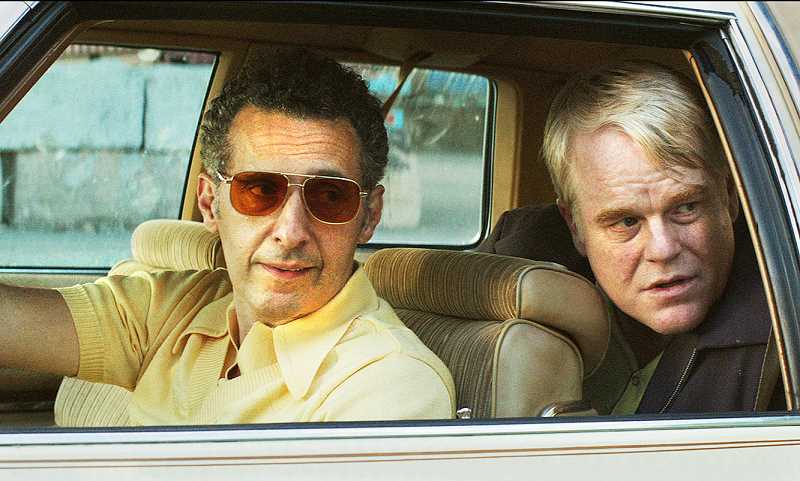In an essay in the Criterion booklet for “Vanya on 42nd Street,” author Steven Vineberg writes: “the project… strips down Chekhov’s late-nineteenth century story (“Uncle Vanya”) about Russian intellectuals in the provinces and reimagines it as a text for Stanislavski-trained American actors.”
This is my vision of cinematic hell, but as I have grown older if not wiser I’ve come to understand that it’s not always about me. “Vanya on 42nd Street” (1994) was definitely not made for me, but it has delighted the audience it was intended for: actors specifically, though theater aficionados in general as well. And it is easy to understand why they’ve embraced this second collaboration between theater director André Gregory and film director Louis Malle.
“Vanya on 42nd Street” captures ensemble stage acting at its most intimate, providing a vantage point on a live performance that few people ever witness. The project originated in 1989 when Gregory, after not having directed a play for more than a decade, gathered a group of friends to perform a new adaptation of Anton Chekhov’s 1897 play “Uncle Vanya,” working from a contemporary adaptation by David Mamet. Gregory and his troupe approached the play at a leisurely pace, and that’s quite an understatement. For more than a year, they performed only for each other, allowing ample opportunity to explore the material and the characters. Eventually, they invited a handful of friends (about twenty or so at a time, sometimes fewer) to watch the performances – done in contemporary street clothes – that still provided them plenty of room for experimentation, leading to radically different performances from night to night. The actors met over the years during free times in their schedule and kept sculpting the roles under the encouraging tutelage of Gregory who claims that an actor simply cannot do something that he won’t love.
Wallace Shawn, Gregory’s sparring partner in Louis Malle’s “My Dinner with Andre” (1981), plays Uncle Vanya, a self-absorbed, depressed intellectual who “could have been the next Dostoevsky” if only fate hadn’t conspired against him. He tends to the country estate headed by his brother-in-law Serebryakov (George Gaynes), a retired professor and writer in the shadow of whose (subsiding) fame the rest of the family lingers. The old and infirm Serebryakov has a lovely new young wife Yelena (Julianne Moore) who catches the fancy of both Vanya and the visiting Dr. Astrov (Larry Pine), the latter much to the chagrin of Vanya’s “plain” niece Sonya (Brooke Smith). These aristocrats and semi-aristocrats are a miserable lot who complain about wasted opportunities, and suffer over their unrequited loves. If they were just a little more gullible, maybe they could really believe the next life would provide all the rewards they were denied in this one. But with the possible exception of Sonya, they don’t even have that escape.
After a while, Gregory and Shawn decided to contact old friend Louis Malle about turning this project into a film. And this is what makes “Vanya on 42nd Street” so special to the viewers that it touches deeply. It preserves this otherwise ephemeral event, this special experiment in intense collaboration staged in the only remaining workable space in the then-dilapidated New Amsterdam theater on (you guessed it) 42nd street. The troupe members had already formed a bond so tight at this point that even the intrusion of a camera crew for two weeks couldn’t dispel that aura of intimacy they had built up over so many years of playing for small crowds or even a crowd of just Andre Gregory. Having an actual document of such a fragile moment seems like a special gift, Malle’s final cinematic gift as he would die the following year.
While the play and the performances aren’t my cups of tea, I respect the film and the inspiring effect it has on some viewers. And even though my interest in the actual material is minimal, I found myself unexpectedly moved while watching the closing credit sequence in which the actors (some of whose characters have left the narrative already) return to center stage to share smiles and congratulations. I appreciated having been let in to their tight-knit world for a few hours. It’s a kind and generous gesture.
Video:
The film is presented in its original 1.66:1 aspect ratio. I really wasn’t expecting too much from this stripped down work of filmed theater, but this 1080p transfer is quite vivid, really bringing out warm flesh tones and a bright color palette all around. There are scenes shot outside of the theater on the busy streets of New York showing the actors arriving and these look vibrant as well. A great job.
Audio:
The LPCM 2.0 soundtrack is pretty straightforward, mixing all of the dialogue clearly and with no distortion. Optional English subtitles support the English audio.
Extras:
The only extra is a new 35-minute documentary mixing interviews with André Gregory and cast members. Everyone who speaks about the film seems to have been deeply moved by the experience – Brooke Smith tears up when talking about finally finishing the project. Julianne Moore, just beginning her rise to film stardom in 1994, says the play/film shaped the rest of her career.
The only other extra is a Trailer.
The 20-page insert booklet includes a new essay by author and theater professor Steven Vineberg, and an on-set essay by critic Amy Taubin which was originally published in the June 21, 1994 edition of the Village Voice.
Film Value:
“Vanya on 42nd Street” was originally released on a Region 1 SD by Sony Pictures in 2002. I don’t have it for comparison, but it’s listed as a 1.85:1 ratio compared to this accurate 1.66:1 release. You only get one extra with this Criterion release, but the proper ratio and the excellent 1080p transfer earn it high marks.


